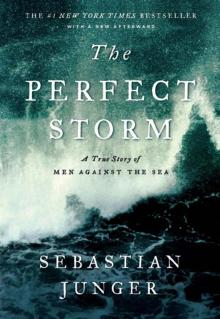- Home
- Sebastian Junger
Fire Page 7
Fire Read online
Page 7
On Monday, July 11, a memorial service was held in Glenwood Springs. While Storm King Mountain smoldered in the background, helicopters flew in formation overhead and people wept to the strains of “Amazing Grace.” President Clinton called Governor Roy Romer from Air Force One, and flags on government buildings throughout the country were at half-mast. At dawn the next day, the bodies of the Prineville nine were driven to Walker Field in Grand Junction and then flown home in a Forest Service DC-3. The remains were delivered to four different airfields in Oregon while honor guards played taps and next of kin received the caskets on the tarmac.
Before the embers were even cold on Storm King Mountain, a ten-member investigation team was convened and given forty-five days to examine the site and deliver its findings. The team was composed of former fire fighters and experts in fire behavior, meteorology, and safety equipment. The question of specific blame, however, was not supposed to arise; it was to be a strictly analytical study of what had happened and when.
The preferred view among most federal fire personnel and even most South Canyon survivors was that the West was apocalyptically dry and huge fires were bound to happen. On such fires, people sometimes die; indeed, there are a few fatalities every year. “I would go out on a fire line again with any person who was there,” insisted the BLM’s Mike Hayes. “We were doing the best we could with the resources we had. I mean, there were fifty fires in our district at the time.”
A siege mentality developed in Glenwood Springs. Questions of specific culpability were construed as lack of respect for the fire fighters and even for the dead. On Monday, July 11, the Glenwood Post ran an article titled “Glenwood Incident Commander: Plans for Escape Worked,” a daring stance to adopt concerning a fire in which fourteen people died. Butch Blanco had told the Grand Junction Daily Sentinel the day before that one smoke jumper (Hipke) who’d escaped had started his run behind the ill-fated Prineville crew. That suggested to him that there had been sufficient time to reach a safe area ahead of the fire. “Whether they [the Prineville nine] didn’t take it seriously, I don’t know,” he said.
The first people to see the dead were the smoke jumpers who had deployed fire shelters below H-1. “I walked straight to the lower group of bodies and called for a helicopter,” said smoke jumper Anthony Petrilli. “They asked if we needed medevac. I told him it was too late for that, and then I walked up the hill and found six more.”
An hour later twenty-six smoke jumpers helicoptered in to investigate further. It was an early, unnatural dusk on the mountain as they picked their way past the charred bodies. They reported eleven dead and three missing. Within an hour, Governor Romer was on the scene; he told the smoke jumpers he wanted to remove the bodies as quickly as possible. The jumpers objected, saying that this was no different from a crime scene and the bodies should be left until someone examined them. Romer abided by their wishes. The next morning investigators began to measure things, ponder the dynamics of the mountain, and coax secrets from the dead.
The first question was how fast the fire had moved, and Haugh’s estimate—that the last three hundred feet were covered in about twelve seconds—turned out to be close. In the end, the investigators confirmed that the fire had covered the quarter-mile slope in about two minutes, hitting its top speed of 18 mph in the dried-out Gambel oak.
The next question was why it had done that. Fire behavior is determined by an incredibly complicated interaction of fuel, terrain, and wind, and there are mathematical models describing the interaction. (The models are programmed into hand-held calculators carried by most incident commanders these days.) The deadly hillside faced west at a 33 to 50 percent slope, and the vegetation on it possessed burning characteristics described in a formula called Fuel Model Number Four. The moisture content of the small dead fuels on Storm King Mountain was around 3 percent. And the live Gambel oak (which had only been partly burned earlier) was several times drier than normal. In a light wind, according to this model, those conditions would produce twenty-three-foot flames spreading at a maximum of seven hundred feet an hour.
That’s a manageable fire, or at least one that can be outrun, but an increase in wind speed can change the situation dramatically. At 7:20 P.M. on Tuesday (less than twenty-four hours before the blowup), the National Weather Service issued a “Red Flag” fire warning for the area around Glenwood Springs. Dry thunderstorms were expected the following morning, followed by southwest winds gusting up to 30 mph. A cold front would come through sometime that afternoon, swinging the winds to the northwest.
Gusts of 35 mph, plugged into Fuel Model Number Four, produce sixty-four-foot flames racing up the mountain at up to fifteen feet per second. In the superdry Gambel oak, the rate of spread would have been almost twice that—much faster than any human can run. The lessons of the Battlement Mesa fire (detailed in the Situation #8 video) had not been learned: A small fire on steep ground covered with extremely dry vegetation had once more exploded in a mathematically predictable way—again, with tragic results.
The 226-page federal investigators’ report concluded that just about everyone involved had been negligent in some way. Ground crews had been arrogant about the fire danger; supervisors had ignored local fuel and drought conditions; and the Western Slope Fire Coordination Center had failed to relay crucial weather information to the fire crews in the field. “Extreme fire behavior could have been predicted by using weather forecasts and information readily obtainable at the BLM Grand Junction District Office,” read one of many such findings.
The most horrifying conclusion of the report was that twelve of the victims could have easily escaped from the valley if they had started running when evidence of extreme danger first emerged. Instead, they began a slow walk, some of them dying with their tools in their hands. This meant two things: The order for an all-out retreat was given far too late, and the victims had an inherent reluctance to acknowledge the seriousness of their situation. “Putting down the saw jacked the pucker factor up one notch,” said smoke jumper Petrilli, who himself had not accepted the fact that he was running for his life until he put down his tools. The last thing fire fighters are supposed to do is give up a saw or shovel, so they are understandably loath to do so, since it means they are in a life-threatening situation.
“I know in my heart,” said Haugh, “that the twelve persons who died in that part of the fire were unaware of what was happening.” By the time the Prineville nine and the three smoke jumpers with them saw the horror coming—by the time great sheets of flame hit the dry Gambel oak and frantic voices over the radio screamed at them to run—they had only twenty seconds to live. They must have died in a state of bewilderment almost as great as their fear.
THE WHALE HUNTERS
1995
The last living harpooner wakes to the sound of wind. It has been blowing for two weeks now, whipping up a big ugly sea, ruining any chance of putting out in the boat. On this strong, steady wind, the northeast trades, European slave ships rode to the New World bringing fifteen million Africans across the Atlantic. One of their descendants now creeps through his house in the predawn gloom, wishing the wind would stop.
The man’s name is Athneal Ollivierre. He is six feet tall, seventy-four years old, straight and strong as a dock piling. His hair rises in an ash gray column, and a thin wedge of mustache suggests a French officer in the First World War. On his left leg, there’s the scar of a rope burn that went right down to the bone. His eyes, bloodshot from age and the glare of the sun, focus on a point just above my shoulder and about five hundred miles distant. In the corner of his living room rests a twenty-pound throwing iron with a cinnamonwood shaft.
Ollivierre makes his way outside to watch the coming of the day. The shutters are banging. It’s the dry season; one rainfall and the hills will be so covered with poui flowers that it will look as if it had just snowed. Shirts hang out to dry on the bushes in front of his house, and a pair of humpback jawbones forms a gateway beyond which sprawls the
rest of his world, seven square miles of volcanic island that drop steeply into a turquoise sea. This is Bequia, one of thirty-two islands that make up the southern Caribbean nation of St. Vincent and the Grenadines. Friendship Bay curves off to the east, and a new airport, bulldozed across the reefs, juts off to the west. More and more tourists and cruise ships have been coming to Bequia, the planes buzzing low, the gleaming boats anchoring almost nightly in the bay, but at the moment that matters very little to Ollivierre. He’s barefoot in the tropical grass, squinting across the water at a small disturbance in the channel. Through binoculars it turns out to be a wooden skiff running hard across the channel for the island of Mustique. It emerges, disappears, emerges again behind a huge green swell.
“Bequia men, they brave,” he says, shaking his head. He speaks in a patois that sounds like French spoken with an Irish brogue. “They brave too much.”
Ollivierre hunts humpback whales from a twenty-seven-foot wooden sailboat called the Why Ask. As far as he’s concerned, his harpooning days are over, but he’s keeping at it long enough to train a younger man, forty-three-year-old Arnold Hazell, to do it. Otherwise the tradition—and the last remnant of the old Yankee whaling industry—will die with him. When they go out in pursuit of a whale, Ollivierre and his five-man crew row through the surf of Friendship Bay and then erect a sail that lets them slip up on whales undetected. Ollivierre stands in the bow of his boat and hurls a harpoon into the flank of an animal that’s five hundred times as heavy as he is. He has been knocked unconscious, dragged under, maimed, stunned, and nearly drowned. When he succeeds in taking a whale, schools on Bequia are let out, businesses are closed, and a good portion of the forty-eight hundred islanders descends on the whaling station to watch and help butcher, clean, and salt the whale.
“It’s the only thing that bring joy to Bequia people,” says Ollivierre, a widower whose only son has no interest in whaling. “Nobody don’t be in their homes when I harpoon a whale. I retired a few years ago, but the island was lacking of the whale, and so I go back. Now I’m training Hazell. When I finish with whalin, I finish with the sea.”
When a whale is caught, it’s towed by motorboat to a deserted cay called Petit Nevis and winched onto the beach; the winch is a rusty old hand-powered thing bolted to the bedrock. Butchering a forty-ton animal is hard, bloody work—work that has been condemned by environmentalists around the world—and the whalers offer armloads of fresh meat to anyone who will help them. Some of the meat is cooked right there on the beach (it tastes like rare roast beef), and the rest is kept for later. The huge jawbones are sold to tourists for around a thousand dollars, and the meat and blubber are divided up equally among the crew. Each man sells or gives his share away as he sees fit. “Who sell, sell; who give, give,” as Ollivierre says. The meat goes for two dollars a pound in Port Elizabeth.
If there is a species that exemplifies the word whale in the popular mind, it’s probably the humpbacks that Ollivierre hunts. These are the whales that breach for whale-watching boats and sing for marine biologists. Though nearly 90 percent of the humpback population has been destroyed in the last hundred years, at least half of the remaining eleven thousand humpbacks spend the summer at their feeding grounds in the North Atlantic and then migrate south in December. They pass the winter mating, calving, and raising their young in the warm Caribbean waters, and when the newborns are strong enough—they grow a hundred pounds a day—the whales journey back north.
It is by permission of the International Whaling Commission (IWC) based in Cambridge, England, that Ollivierre may take two humpbacks a year. In 1986 a worldwide moratorium was imposed on all commercial whaling, but it allowed “aboriginal people to harvest whales in perpetuity, at levels appropriate to their cultural and nutritional requirements.” A handful of others whale—in Greenland, Alaska, and Siberia—but Ollivierre is the only one who still uses a sailboat and a hand-thrown harpoon. These techniques were learned aboard Yankee whaling ships a hundred years ago and brought back to Bequia without changing so much as an oarlock or clevis pin.
“You came and put a piece of your history here, and it’s still here today,” says Herman Belmar, a local historian who lives around the corner from Ollivierre. Belmar is a quiet, articulate man whose passion is whaling history. He is trying to establish a whaling museum on the island. “Take the guys from Melville’s Moby-Dick and put them in Athneal’s boat, and they’d know exactly what to do.”
One day at dawn I drive over to meet Ollivierre. His house is a small, whitewashed, wood and concrete affair on the side of a hill, surrounded by a hedge. Except for the whalebone arch, it’s indistinguishable from any other house on the island. I let myself through a little wooden gate and walk across his front yard, past an outboard motor and a vertebra the size of a barstool. It’s mid-February, whaling season, and Ollivierre is seated on a bench looking out across the channel. I stick out my hand; he takes it without meeting my eye.
By Bequia standards, Ollivierre is a famous man. Many people have stood before him asking for his story, but still I’m a little surprised by his reaction. Not a word, not a smile—just the trancelike gaze of someone trying to make out a tiny speck on the horizon. I stand there uncomfortably for a few minutes and finally ask what turns out to be the right question: “Could I see your collection?”
If you wander around Port Elizabeth for any length of time, a taxi driver will inevitably make you the offer: “Come meet the real harpooner! Shake his hand, see his museum!” A museum it’s not, but Ollivierre has filled the largest room of his house with bomb guns, scrimshaw, and paintings. The paintings are by a local artist and commemorate some of Ollivierre’s wilder exploits: Athneal Done Strike de Whale, reads one. As Ollivierre discusses his life, he slowly becomes more animated and finally suggests that I walk up to the hilltop behind his house to meet the rest of the crew.
A path cuts up the hill past another low wood and concrete house. Split PVC pipe drains the roof and empties into a big concrete cistern, which is almost dry. (Every drop of drinking water on Bequia must be caught during the rainy season.) At the top of the hill are some wind-bent bushes and a thatch and bamboo sunbreak that tilts south toward the sea. Four men sit beneath it, looking south across the channel. They gnaw on potatoes, pass around binoculars, suck on grass stems, watch the sky get lighter. In the distance is a chain of cays that used to be the rim of a huge volcano, and seven miles away is the island of Mustique. When the wind permits, the whalers sail over there to look out for humpbacks.
“Hello. Athneal sent me,” I offer a little awkwardly.
The men glance around. There’s been some bad press about whaling, even the threat of a tourist boycott, and everyone knows this is a delicate topic. An old man with binoculars motions me over. “We can tell whatever you want,” he says, “but we can’t do anything without Dan, de cop’m.”
After Ollivierre, Dan Hazell, who bears some distant relation to Arnold Hazell, is the senior member of the crew. He’s the captain, responsible for maneuvering the boat according to Ollivierre’s orders. A young man named Eustace Kydd says he’ll round up Dan and a couple of others and meet me at a bar in Paget Farm. Paget Farm is a settlement by the airport where the whalers live: ramshackle houses, dories pulled up on rocks, men drinking rum in the shade. Most of the men on the island make their living net fishing. I nod and walk back down the hill. Ollivierre is still in his yard, glassing the channel and talking to a young neighborhood man who has dropped by. They give me a glance and keep talking. The wind has dropped; the sun is thundering impossibly fast out of the equatorial sea.
Unfortunately for Ollivierre, the antiquity of his methods has not exempted him from controversy. First of all, he has been known to take mother-calf pairs, a practice banned by the IWC. In addition, Japan started giving St. Vincent and several neighboring islands tens of millions of dollars in economic aid after the imposition of an international moratorium on whaling in 1986. The aid was ostensibly to develop local fisheri
es, but American environmental groups charged that Japan was simply buying votes on the IWC. The suspicions were well founded: St. Vincent, Dominica, and Grenada have received substantial amounts of money from Japan, and all have voted in accordance with Japan’s whaling interests over and over again.
Things came to a head last year when the IWC introduced a proposal to create an enormous whale sanctuary around Antarctica. The sanctuary would offer shelter to whales as the worldwide moratorium was phased out in keeping with growing whale populations. The Massachusetts-based International Wildlife Coalition, headed by Dan Morast, threatened to organize a tourist boycott against any country that voiced opposition to the proposal, and in the end only Japan voted against it. St. Vincent, Dominica, and Grenada abstained from the vote, and the South Seas Sanctuary was passed.
But the controversy over Bequia is more emotional than a vote. Ollivierre has become the focal point for dozens of environmental lobbyists, for whom everything he does is drenched in symbolism. First there was Ollivierre’s flip-flop: In 1990 he announced his retirement, but a year later he was back at it, sitting on his hilltop, looking out for whales. It was a move that angered environmentalists who thought they’d seen the last of whaling on Bequia. The reaction was compounded by Ollivierre’s efforts to sell the island of Petit Nevis, the tiny whaling station that has belonged to his family for three generations; a Japanese businessman’s offer of five million dollars was an outrage. Of course, Ollivierre’s personal impact on the humpback population is negligible. Morast’s point seems to be more conceptual: that the land sale is just another form of bribery to encourage the St. Vincent representative on the IWC to vote for whaling.

 War
War The Perfect Storm: A True Story of Men Against the Sea
The Perfect Storm: A True Story of Men Against the Sea A Death in Belmont
A Death in Belmont Fire
Fire The Perfect Storm
The Perfect Storm A World Made of Blood (Kindle Single)
A World Made of Blood (Kindle Single)